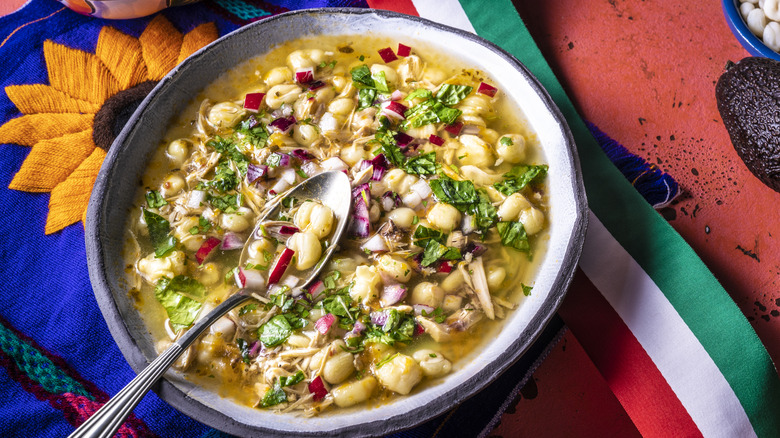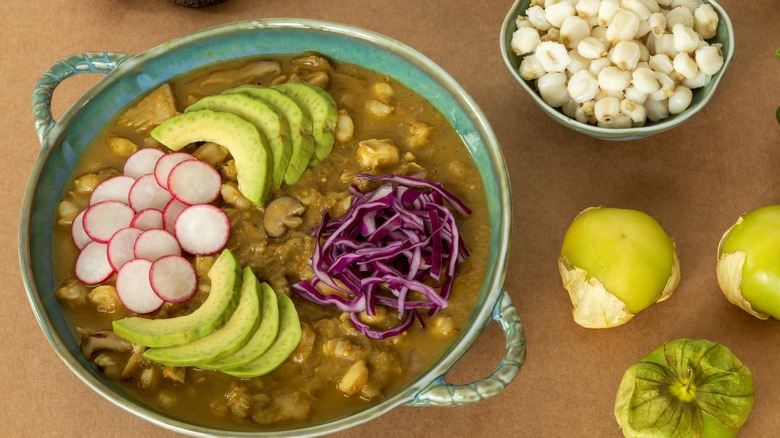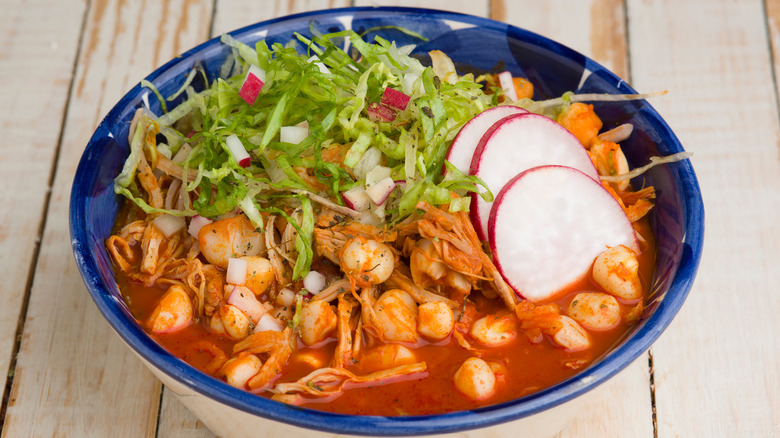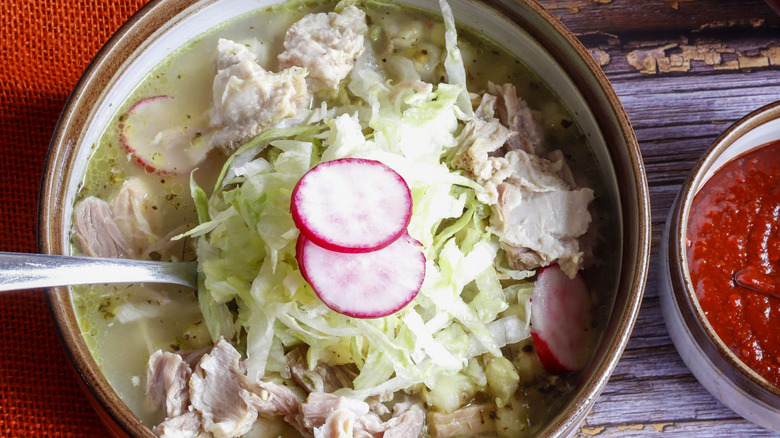The 3 Types Of Pozole, Explained
Pozole is a classic Mexican corn stew that comes in three main varieties: pozole verde (green pozole), pozole rojo (red pozole), and pozole blanco (white pozole). Each is a variation on the same dish, and the ingredients are changed to create unique color structures — red, green, and white being the colors of the Mexican flag — and strong, spicy flavor profiles.
Pozole is a Mexican culinary institution that can be traced back thousands of years. The main ingredient, hominy, was considered to be the most important crop in the ancient Mesoamerican world. Hominy is made by shelling corn kernels and submerging them in a mixture of water and lime so they soften and become enlarged.
Corn was considered a sacred plant by the Aztecs, so pozole was enjoyed only on the most special occasions, i.e. the ritual sacrifice of Aztec enemies. The hearts and flesh of said enemies would be added to the stew as a way of honoring the god of love, fertility, and agriculture. With the Spanish conquest of Mexico in the 16th century, cannibalism was outlawed and pork became the staple meat for pozole.
Modern Mexican families like to cook up pozole on the weekend or for special holidays and events like weddings, typically adding their own personal flair to the classic stew. While there is no wrong way to make pozole, the green, red, and white variations are the most common and bring their own distinct flavors to this most ancient tradition.
Tangy and bold pozole verde
Pozole verde comes from the Guerrero state on the Pacific coast of southern Mexico. As implied by its name, the primary color of this iteration of pozole is a luscious green. This color is derived from one of Mexico's most iconic sauces: salsa verde.
Salsa verde is a combination of very acidic and spicy green ingredients, starting with tomatillos. Though their name translates as "little tomatoes," tomatillos are very much their own fruit. Native to Mexico, these vibrantly green, compact little fruits are very acidic and have far less water content than a standard tomato. Tomatillos serve as the base for the salsa verde, but much of the heat comes from a variety of different green chiles like serrano, jalapeño, and poblano. Cilantro and onion are also added to round out the salsa.
The salsa verde gives the stew a spicy kick and, thanks to the savoriness of the tomatillos, pairs very well with the traditional pork. Chicken has also become a favorite meat for pozole, but you can create a vegetarian version of this stew by omitting meat all together and using vegetable broth and beans instead. Though it will likely be lighter, the flavors of the stew will still make a statement.
Earthy and robust pozole rojo
Deep red pozole rojo is commonly found in Mexico City and the surrounding area. It is notable for it's definitive red color, bold earthiness, and it's traditional use of two different cuts of pork to achieve a rich flavor. The head and neck of the pig, which are loaded with fat, are cooked along with the hominy to create a very dark and savory flavored broth. However, you can use any other cut of fatty pork, such as pork butt and spare ribs, to achieve the same effect.
While the pork broth provides a rusty hue to the broth, the red of the stew comes from chiles. This time, however, red chilies like ancho, árbol, and guajillo are used. These chiles are as hot, if not occasionally hotter than green chiles. They are usually more sweet than their bitter green counterparts, leading to a more savory and robust flavor for the stew.
You can make pozole rojo with chicken or pork as before, but this version benefits greatly from bright or creamy garnishes like avocado, lettuce, cabbage, lime, cilantro, radishes, and tortilla chips. The garnishes add an extra bit of freshness to this savory stew. While the green and red variations are the more immediately recognizable pozole, there is a third option worth knowing, especially if you are not one for lots of spice.
Mild but flavorful pozole blanco
Pozole blanco doesn't actually take its name from any color coordinating ingredient. There is no milk or cheese to be found in this stew, though the hominy tends to take on a more opaque color when cooked. The blanco comes from the fact that this particular iteration of pozole leaves out chile sauce entirely, therefore, creating a far milder stew that relies on the meat and hominy to bring out its flavor.
All pozole starts as pozole blanco. The hominy, which has a texture and taste similar to that of a corn tortilla, provides a starchy building block from which to construct a flavor profile. Form there, you can add your meat of choice or stick with vegetables. Pozole blanco is a great pozole option for vegetarians specifically because of the fact that it is lighter and more mild than the green or red versions. For example, one could use mushrooms instead to make an excellent meaty swap for pork.



